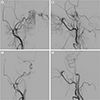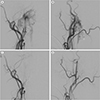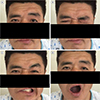Abstract
The Onyx liquid embolic system is a relatively safe and commonly used treatment for vascular malformations, such as arteriovenous fistulas and arteriovenous malformations. However, studies on possible complications after Onyx embolization in patients with vascular malformations are limited, and the occurrence of cranial nerve palsy is occasionally reported. Here we report the progress of two different types of cranial nerve palsy that can occur after embolization. In both cases, Onyx embolization was performed to treat vascular malformations and ipsilateral oculomotor and facial nerve palsies were observed. Both patients were treated with steroids and exhibited symptom improvement after several months. The most common types of neuropathy that can occur after Onyx embolization are facial nerve palsy and trigeminal neuralgia. Although the mechanisms underlying these neuropathies are not clear, they may involve traction injuries sustained while extracting the microcatheter, mass effects resulting from thrombi and edema, or Onyx reflux into the vasa nervorum. In most cases, the neuropathy spontaneously resolves several months following the procedure.
Arteriovenous fistulas (AVFs) lead to abnormal shunting of blood between the arterial and venous systems and lack a normal, intervening capillary bed.2) AVF management frequently includes endovascular, surgical, and radiosurgical treatment, either alone or in combination.13) Currently, the primary treatment usually involves endovascular techniques, allowing for both arterial and venous access to the site of the fistulous connection. Such techniques are preferred because of their ability to directly catheterize the lesion and place embolic material directly at the site of the abnormal arteriovenous connection.2)12) Most AVFs can be successfully and safely managed with endovascular techniques.12)
Transarterial Onyx (ev3, Irvine, CA, USA) embolization is an established method of AVF treatment.3)12)15) Several cases describing transarterial Onyx embolization of AVFs have been published, each exhibiting low rates of postoperative complications.8)9)12)13)14)16)18) The most common types of neuropathy that can occur after Onyx embolization include facial nerve palsy and trigeminal neuralgia.14) However, the mechanisms underlying these neuropathies are not well described.4)
Here we report two cases of transient cranial injury after Onyx embolization, both of which spontaneously resolved within several months.
This case report followed the guidelines of the Declaration of Helsinki for studies involving humans.
A 55-year-old female patient was admitted to our hospital because of diplopia and left eye pulsatile sensation. Magnetic resonance imaging (MRI) at presentation revealed a vascular malformation. Angiography confirmed a carotid-cavernous fistula (CCF) supply arising from the bilateral deep temporal arteries. On June 18, 2015, the patient underwent a transarterial approach involving the left external carotid artery (ECA). Multiple ECA branches were embolized using 1 mL ethyl vinyl alcohol (ev3 Onyx 18). No specific finding was noted during the procedure, but the patient complained of temporary facial numbness after the surgery. On July 2, 2015, Onyx embolization was performed on the right CCF (Fig. 1). No specific finding was noted during the procedure, but on the following day, third nerve palsy and facial numbness were observed (Fig. 2). She was discharged after initiating the steroid treatment. Her third nerve palsy recovered partially 2 months after discharge and completely 7 months after discharge.
A 51-year-old male patient was admitted to our hospital because of right pulsatile tinnitus. Computed tomography and MRI obtained during work-up suggested the presence of an AVF. AVF arising from the right posterior auricular artery and right occipital artery was detected on angiography. Transarterial approach involving the right ECA was employed, and the right ascending pharyngeal artery was embolized using ethyl vinyl alcohol (ev3 Onyx 18) (Fig. 3). No specific finding was noted during the procedure. On the following day, right facial nerve palsy symptoms appeared (House-Brackmann GV) (Fig. 4), and the patient was placed on steroid therapy. His facial nerve palsy (House-Brackmann GII) recovered partially 2 months after discharge and completely 3 months after discharge.
Here we report one case of transient facial nerve palsy and one of oculomotor nerve palsy, which occurred after transarterial Onyx embolization of arteriovenous shunting lesions. These symptoms naturally resolved over the ensuing months.
Many hospitals use endovascular treatments for AVF as a first-line treatment to reduce the risk of intracerebral hemorrhage (ICH) by eliminating direct cortical venous drainage.13)16) In the past, surgical treatments were popularly performed for treating vascular malformations, and endovascular treatments were performed using the transvenous technique. Recently, transarterial techniques are widely used to treat vascular malformations because of the development of liquid embolizates, such as Onyx.16)
Onyx is a biocompatible non-adhesive liquid embolic agent comprising 20% ethylene vinyl alcohol copolymer and dimethyl sulfoxide (DMSO) solvent added to micronized tantalum powder, a high-molecular weight metal that renders the solution radiopaque.17) The polymer concentration of Onyx is higher than that of other liquid embolizates, resulting in a higher viscosity. This reduces thromboembolic events by reducing the likelihood of reflux to parent vessels.17) Because of these advantages, Teufack et al. and Weber et al. used Onyx to treat a giant aneurysm.19)
Despite these advantages, it is known that complications, such as microcatheter gluing, pulmonary and cardiac Onyx migration, reflexive bradyarrhythmia, cranial nerve damage, cerebellar infarction, hallucinations, and jaw pain may occur during Onyx transarterial embolization.12)
The pathogenesis of cranial nerve palsy following Onyx embolization is not clear, but several hypotheses have been proposed. Lv et al.12) has argued that although the Onyx material refluxes into the middle meningeal artery, occlusion occurs in the vasa nervorum, such as cavernous branch and petrosal branch, causing trigeminal and facial nerve deficits. Therefore, he recommended caution regarding Onyx reflux to the level of the foramen spinosum when using the transarterial technique. In addition, the direct toxic effects of DMSO may be related to cranial nerve palsy,5) but it is presumed that the highest concentration of DMSO is microcatheter tip, which is less likely to have a difference in location from the cranial nerve injury site.14) Direct axonotmetic injury can also potentially occur when the microcatheter is pulled from the Onyx cast during microcatheter retraction.14) The onset of cranial nerve palsy after onyx embolization is a time-consuming procedure that can be used to support the axonometric injury rather than the direct toxic effect of DMSO.7)14) Axonotmesis is a well-known sequela of traction nerve injury.6)11)14) Reports and studies on cranial nerve palsy occurring after transarterial Onyx embolization have not yet clearly identified the causative mechanisms.
Kupfer et al. reported facial nerve palsy after transarterial Onyx embolization in patients with DAVF,10) in whom complications resulted from Onyx reflux into the vasa nervorum.10) In the study by Nyberg et al, transarterial Onyx embolization was performed on patients with DAVF and arteriovenous malformations and facial nerve palsy and trigeminal nerve mandibular segment (V3) neuralgia were present in all patients.14) In their study, microcatheter retraction from Onyx casts was identified to cause symptoms through axonotmetic injury.14) Abud et al. reported four cases of cranial neuropathy, two of facial nerve palsy, and two of trigeminal neuralgia.1) Although the mechanisms of injury in their study were unclear, the authors reported that middle meningeal artery reflux1) cuased the onyx material. In the above cases, symptoms improved spontaneously.1)10)14)
These studies, including our cases, demonstrate the risk of Onyx reflux while performing transarterial Onyx embolization near cranial nerve areas. We should be careful to minimize the Onyx cast on the microcatheter tip to reduce the potential for cranial nerve injury during catheter retraction. Nevertheless, if cranial palsy occurs after Onyx embolization, conservative treatment is indicated in most cases because typically, symptoms spontaneously improve within a few months.
AVF is a relatively rare vascular lesion requiring considerable treatment if accompanied by other symptoms. Transarterial Onyx embolization is a relatively safe treatment for AVF; however, it can lead to complications, such as facial or oculomotor nerve palsy. These complications are likely due to axonotmetic injury, but neurointerventionists and patients should be aware that spontaneous recovery of nerve function is likely.
Figures and Tables
Fig. 1
Endovascular embolization by Onyx. (A, B) Preoperative left external carotid artery images (antero-posterior view, lateral view); (C, D) postoperative left external carotid artery images (antero-posterior view, lateral view). After Onyx embolization, carotid-cavernous fistula flow through the right external carotid artery disappears.

Fig. 2
Postoperative right oculomotor nerve function test. (A) Frontal gaze; (B) lateral gaze; (C) medial gaze; (D) ptosis in the neutral position.

Fig. 3
Endovascular embolization by Onyx. (A, B) Preoperative right external carotid artery images (antero-posterior view, lateral view); (C, D) postoperative right external carotid artery images (antero-posterior view, lateral view). After Onyx embolization, arteriovenous fistula flow through the left external carotid artery disappears.

References
1. Abud TG, Nguyen A, Saint-Maurice JP, Abud DG, Bresson D, Chiumarulo L, et al. The use of Onyx in different types of intracranial dural arteriovenous fistula. AJNR Am J Neuroradiol. 2011; 12. 32(11):2185–2191.

2. American Society of Interventional and Therapeutic Neuroradiology. Arteriovenous fistulae of the CNS. AJNR Am J Neuroradiol. 2001; 09. 22:8 Suppl. S22–S25.
3. Arat A, Inci S. Treatment of a superior sagittal sinus dural arteriovenous fistula with Onyx: technical case report. Neurosurgery. 2006; 07. 59:1 Suppl 1. ONSE169–ONSE170. discussion ONSE 169-70.

4. Chen J, Crane B, Niparko J, Gandhi D. Direct intraoperative confirmation of penetration of ethylene vinyl alcohol copolymer (Onyx) into the vasa nervosa of the facial nerve. J Neurointerv Surg. 2012; 11. 4(6):435–437.

5. Elhammady MS, Peterson EC, Aziz-Sultan MA. Onyx embolization of a carotid cavernous fistula via direct transorbital puncture. J Neurosurg. 2011; 01. 114(1):129–132.

6. Gallas-Torreira MM, Reboiras-Lopez MD, Garcia-Garcia A, Gandara-Rey J. Mandibular nerve paresthesia caused by endodontic treatment. Med Oral. 2003; Aug-Oct. 8(4):299–303.
7. Ge XX, Spector GJ, Carr C. The pathophysiology of compression injuries of the peripheral facial nerve. Laryngoscope. 1982; 10. 92:10 Pt 2 Suppl 31. 1–15.
8. Hu YC, Newman CB, Dashti SR, Albuquerque FC, McDougall CG. Cranial dural arteriovenous fistula: transarterial Onyx embolization experience and technical nuances. J Neurointerv Surg. 2011; 03. 3(1):5–13.

9. Huang Q, Xu Y, Hong B, Li Q, Zhao W, Liu J. Use of onyx in the management of tentorial dural arteriovenous fistulae. Neurosurgery. 2009; 08. 65(2):287–292. discussion 292-3.

10. Kupfer TJ, Aumann K, Laszig R, Meckel S. Peripheral facial palsy after embolization of a dural arteriovenous fistula with Onyx®. HNO. 2011; 05. 59(5):465–469.
11. Logigian EL, Mcinnes JM, Berger AR, Busis NA, Lehrich JR, Shahani BT. Stretch-induced spinal accessory nerve palsy. Muscle Nerve. 1988; 02. 11(2):146–150.

12. Lv X, Jiang C, Zhang J, Li Y, Wu Z. Complications related to percutaneous transarterial embolization of intracranial dural arteriovenous fistulas in 40 patients. AJNR Am J Neuroradiol. 2009; 03. 30(3):462–468.

13. Nogueira RG, Dabus G, Rabinov JD, Eskey CJ, Ogilvy CS, Hirsch JA, et al. Preliminary experience with onyx embolization for the treatment of intracranial dural arteriovenous fistulas. AJNR Am J Neuroradiol. 2008; 01. 29(1):91–97.

14. Nyberg EM, Chaudry MI, Turk AS, Turner RD. Transient cranial neuropathies as sequelae of Onyx embolization of arteriovenous shunt lesions near the skull base: possible axonotmetic traction injuries. J Neurointerv Surg. 2013; 07. 5(4):e21.

15. Rezende MT, Piotin M, Mounayer C, Spelle L, Abud DG, Moret J. Dural arteriovenous fistula of the lesser sphenoid wing region treated with Onyx: technical note. Neuroradiology. 2006; 02. 48(2):130–134.

16. Stiefel MF, Albuquerque FC, Park MS, Dashti SR, McDougall CG. Endovascular treatment of intracranial dural arteriovenous fistulae using Onyx: a case series. Neurosurgery. 2009; 12. 65:6 Suppl. 132–139. discussion 139-40.

17. Teufack S, Tjoumakaris S, Gonzalez F, Dumont A, Rosenwasser R, Jabbour P. Cranial nerve palsy after embolization of giant cavernous carotid aneurysm with Onyx HD-500: case series and review of the literature. JNH Journal. 2011; 6(1):22–24.

18. Trivelato FP, Abud DG, Ulhoa AC, Menezes Tde J, Abud TG, Nakiri GS, et al. Dural arteriovenous fistulas with direct cortical venous drainage treated with Onyx: a case series. Arq Neuropsiquiatr. 2010; 08. 68(4):613–618.

19. Weber W, Siekmann R, Kis B, Kuehne D. Treatment and follow-up of 22 unruptured wide-necked intracranial aneurysms of the internal carotid artery with Onyx HD 500. AJNR Am J Neuroradiol. 2005; 09. 26(8):1909–1915.




 PDF
PDF ePub
ePub Citation
Citation Print
Print




 XML Download
XML Download